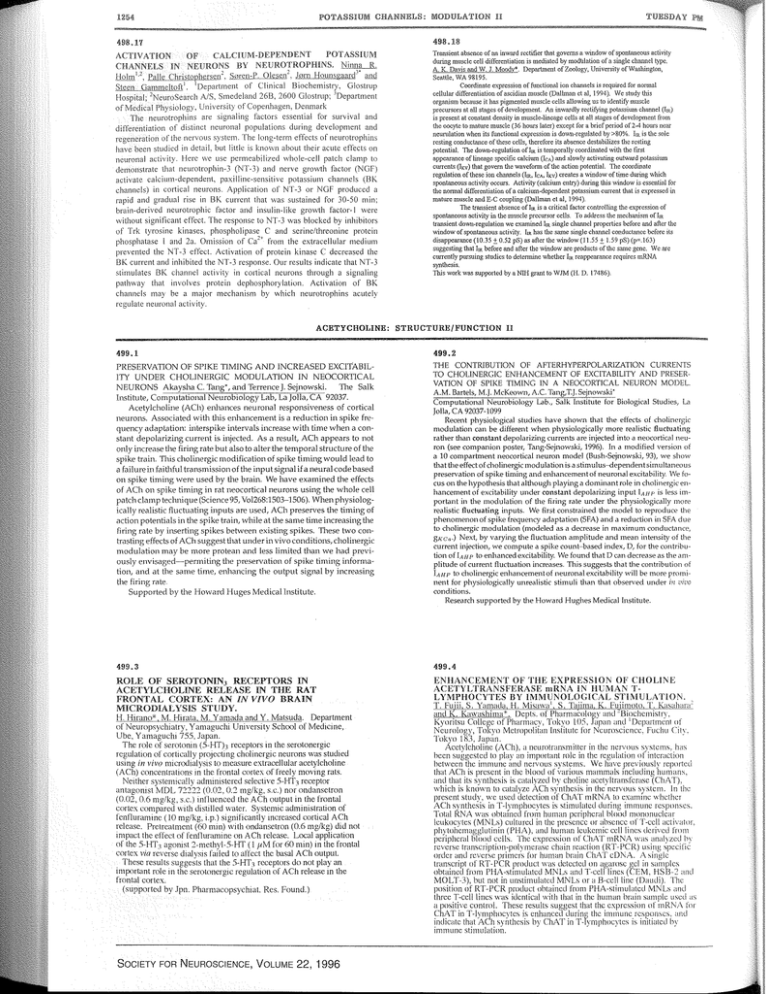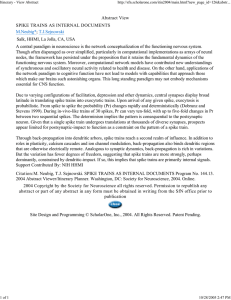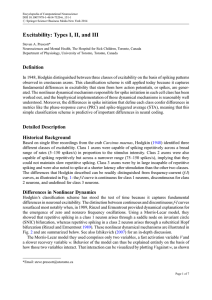Document 10493820
advertisement

ACI'IVATION
OF
CALCIIJM-DEPENDENT
POTASSIUM
CHANNELS TN N E l J R O v S BY NEUROTROPHINS. N i n n d R .
kiolm',',
palie Christo!hxsen-. Soreti-P. 01esci12. ~LKLkkllU!&d"
&en ~ a ~ n m c l t o f t ''.~ e ~ a r t m e noft Clinical Biochemistry, Giostrup
liospital; 2 ~ e ~ ~ r o ~ eA!S,
a r cSmedeland
i~
26B, 2600 Glostrug; 3 ~ e p a i i m e n t
o f ~ c d i c a pllysio[ogy,
l
Univcrsiij of Copenhagen, t h m i a r k
Tile neurotrophitis arc signaling factors essential for survival and
differentiation of distinct ncilronal populations during development and
regeneration of tile Ilen 011s SyStclll. ' h e 10llg-terill effects of neurotrophins
ilavc heen studicd in detail, but littic is known about their acute effects on
lieuronal activity. liere wz use permeabili~edwhole-cell patcli clamp to
cie~nozisrratet h ~ tncurotrophin-3 ( M - 3 ) and nerve growtli factor (NGF)
activate caiciiim-dependent, paxilline-scnsiti\,c potassium channels (13K
channels) in cortical neurcins. Application of PI'T-3 or NGF produced a
rapid and gradual rise in BK current that was sustained for 30.50 iiiin:
brain-derived neurolrophic factor and insulin-like growth factor-l were
wiil~outsignificant effect. The response to NT-3 was blocked by inhibitors
of Trk tyrosine kinases. pl~ospliolipase C and scrinc/threoninc pi-otcin
pliospliatase 1 and 2a. Omission of ca2+ kom tile extracellular medium
prevented the NT-3 effect. Activation of protein kinase C decreased the
BK current and inhibited the NT-3 response. Our results indicate that NT-3
stiniulates BK cliannel activit) in coiiical neurons tlirougli a signaling
paillway that involves proteiri depliospl~orylation. Activation of BK
cliaiinels ma? he a major mechanism by whicl~ neurotrophins acutel)
rcgulate neuruniil activity.
'lmnsient nbscnce of an inward rectifia that governs a mdow of spontaneous activity
dunng muscle cell differentiationis nlediated by modlilation of a single channel type
A. K.Davis and W. J. Moodv*. Depariment of Zwlogy, University of Washington,
Seattle, WA 98195.
Cwrdinate expression of functional ion chmiels 1s rcqurred for nonnal
cellular differentiationof ascidinn muscle (Dallmm ct nl. 19941. Wc studv this
Ir >iii i h. I>; $1 !I.-,y t t n . t ~ J11, i..': ,.:I,. I I t l w ~ i :u.
':$ilm iirr..ic
499.1
499.2
THE CONTRIBUTION OF AFTERHYPERPOLARIZATION CURRENTS
TO CI-IOLINERGTC ENHANCEMENT OF EXCITABILITY AND PRESERVATION OF SPIKE TIMING IN A NEOCORTICAL NEURON MODEL.
A.M. Bartels, M.J. McKeown, A.C. Wng,T.J.Sejnourski'
Computational Neurobiology Lab., Salk Instihrte fo;Biological Studies, La
Jolla, CA 92037-1099
Recent physiological stud~eshave shown that the effects of cholinergic
modulation cam be different when physiologically more realistic fluctuating
rather t h m constant depolarizing currents are injected into a neocortical neuron (see companion poster, Tang-Sejnowski, 1996). In a modified version of
a 10 compartment neocortical neuron model (BushSejnowski, 93), we show
that the effect of cholinergicmodulation is a stimulus-depe~ide~itsitnultaneous
preservation of spike timing and enhancen~entof neuronal excitability We focus on the hypothesis that although playing a dominant role in cholinergic enhancement of excitability under constant depolarizing input 1,tnp is less tinportant in the modulation of the firing rate under tlie physiologically more
realistic fluctuating inputs. We first constrained tlie model to rep~oducethe
phenomenonof spike frequency adapk~tion(SFA) and a reduction in SFA due
to cholinergic modulation (modeled as a decrease in maximum conductance,
gnc..) Next, by varying the fluctuation amplitude and mean intensity of tlie
current injection, we compute a spike count-based index, D, for the contriiwtion of I,,,,p to enhanced excit~bilityWe found that D can decrease as the aniplitude of current fluctuation increases. This suggests that the contributioii of
I.,.....
r r r ~to choliner~ic
enhancement of neuronal excitabilitv will be more orominent for physiolonically
., , unrealistic stimuli than that observed under iti i x i v
conditions.
Research supported by the Howard Hughes Medical Institute.
PRESERVATION OF SPIKE TIMING A N D INCREASED EXCITABILITY UNDER CHOLINERGIC MODULATION I N NEOCORTICAL
NEURONS Akaysha C. l i n g - , a n d Terrence J. Sejnowski. The Salk
Institute, Computational N e ~ r o b i o l o g yLab, La Jolla, C A 92037.
Acetylcholine (ACh) enhances neuronal responsiveness of cortical
neurons. Associated with this e~iliancementi s a reduction in spike frequency adaptation: interspike intervals increase with time when a c o m
stant deyolarizing current i s injected. A s a result, ACli appears to not
only increase the firing rate but also to alter the temporal structure of the
spike train. This cliolu~ergicmodification of spike timing would lead to
a failurein faithful transniission of the input signal if a neuralcodebased
o n spike timing were used b y the brain. We have examined the effects
of ACh o u spike timing in rat neocortical neurons using the whole cell
patch clamp technique (Science 95, Vo1268:1503-1506). When physiologically realistic fluctuating inputs are used, ACli preserves the timing of
action potentials iii the spike train, while at the s a m e time increasing the
firing rate b y inserting spikes behveen existing spikes. 'Iliese two conhasting effects of ACh suggest that under invivo conditions, clioli~iergic
modulation m a y be more protean a n d less limited than w e h a d p r e w
ously envisaged-prrniitil~g the pnservation of spike timing information, a n d a t thp s a m e time, etlhancing the output signal b y increasing
t!ie firing rate
Supported b y the Howard H u g e s Medical Institute.
1.
I
ici.xr; r,
2.1
..I1
.I
r., id. .I
ti, .w
!.u,
,!,,,..,:I\
rc.ui\in<
13
,i
..IIIIO
_ l i .mi(
I I. ,
is oresent d constant densltv in muscle-linenee cells nt all staoes of deveio~mentfrom
resting conductance of these celhiherefoie its absen& destabilizesthe resting
potential. The dow-regulation of Iin is ternparally coordinated with the fust
appo3"anu:of lineage specific calcium (In) <andslowly activating outward potassium
currents (Ixv)that govern the waveform of tlie action pokntial. The coordinate
regulation of these ion channels (Im, ICA,It") creates a mndow of time during which
spontaneous activity occurs. Activity (calcium entry) dwing this window is essential for
the normal differentiationof a calcium-dependent potassium current that is expressed in
mature muscle mid E-C ~ouplhp(Dallman el nl, 1994)
The trmsient absence oflm is a critical factor controlling the expression of
spontaneous activity in the musclc precursor cclls To address Ihe mechanism of lm
transient down-regulation we exanlined ilxsingle chamd properties before and nRer the
mndow of sponheous activit)..Iin has Ux .sane sit& channel conductancebefore its
disappearance (10.35 k0.52 pS) as atkithe window (ll.552 1.59 pS) (p=.lG3)
suggesting that bn before and aRer the window arc products ofthe same gene. We are
cwrently pursuing studies to determinewhetl~erIm reappearance requires niRNA
synLhesis.
nus work was supported by oNVi grant to W m ( H D. 17486)
ROLE OF SEROTOMIIWq RECEPTORS IN
ACETnCNOLlNE RECEASE IN THE
FRONTAL CORTEX: AN IN VIVO BR
T h e role of sertrtontn (5-HT)3 receptors In the serotonerglc
rceulat~onofcor~tcallv
c l i o l ~ n c r e neurons
~c
was studied
,orotcctlnz
" ,
using itr vivo nncrodlalys~sio measure extracellular acetylcholine
(ACh) concentral~onsIn the ironral cortex of freely movlng rals.
Nctther system~callyadrn~nrstercifselective 5-H'T3 receptor
a n t a p n l s t M D L 72222 (0.02, 0.2 mgikg. s.c.) nor ondansctron
(0.02, 0.6 mglkg, s.c.) ~ n f l u c n c c dt l ~ cACh output In the frontal
cortcx compared w t h distilled \rater. S y s t c m ~ admmstratton
c
of
~ncreasedcol-tml ACh
fcnfluranr~nc( 10 mgikg, 1.p.) slgn~f~cantly
rcleasc. Prctrcaimcnt (MI nun) w ~ t hondansctron (0.6 mglkg) d ~ not
d
inipacl thc cfieci o i ienlluranrlnc on ACh release. Local appl~cation
o l the 5-HT3 agonlst 2-mcihyl-5-I-IT ( 1 y M 1.m 60 nun) rn the frontal
cortcx via rcvcrsc dlalysls Palled to aflcct the basal ACli output.
Thcsc results suggests that the 5-HI'? receptors d o not play an
irnprtant role in tile serotoncrgic regtilatmn o l ACh release In the
lt-onlal cortex
(supported by Jpn. Pharmacopsych~at.Res. Found.)
-
N&urology,Tc&y Mctropoliian Snsiitittc for N'curmcicncc: Fuclii~('it!.
'l'okvo 183. Jalmi.
Acetylchnlihc (ACh). ;I ncurotrmsmittci- in the iicrvous s \ stcms. has
hccn s u & s t c d tn play ; ~ nimprxtant role in the reguliiiion oiintcraciion
hctuccn the immune imd nervous systems. Wc IWY j~rcviousl!. rcportcci
t h d ACli is present in tlic hlood oC mrious m;nnm;tls rncludirig h u m ; ~ i ~ i .
and that its synthesis is c;~talyzeilI)y cholinc ;cctyltransicnisc (ChAT).
which is known to c;~t;~l\zc
ACh .;ynthcsis in the ncrvoits a) stctn. 111tlic
Drescnt stuclv. w c used tlctcction of ChAT mRN/\ to csaminc whcihcr
leukocytes (MNL\) cniturcd in thc prc;crtdc or nhscncc d l ' - c e l l nctivatm.
pliyt~~l~crnaggl~~tinin
(PIHA), and human lcukcniic cell lines rlcriicd lioin
pcripiicr;d 11111odcclls. 'l'l~ccsprcssim o i ChKT mRNA w i s a n a l \ ~ c i h\
l
rcvcisc transciiption-pul! mcnisc chain ~cactiori(IIT-I'CR) usiiig ;pccili6
order ancl rcicrsc pritnc~sfor iiuni;tn biain C I v U c D h A A siiigic
transcript of RT-PCR product xias ilctcctcd on agalosc ucl i ~ saiiiplcs
i
obtaincil irom PHA-stnnulatcd MNLi iuid T-ccll lincs (?EM. HSB-2 : i d
MOLT-l), but riot in unstilnulatcd MNLb or a R-cell liiic (1)itudi). l h c
pr,sition of RT-PCR prnduct obt;iincil i r m PIHA-slimuk~tcrlI M S L ~;~ncl
thrcc T-ccll lincs \\.as identical with that in the huinan bri~iri%mipic ii\cil a i
;I pnsitivc control. Thcsc rcsuSls suggest t11;rt thc csprcssion uf tnRN,\ tot
ChAT in T - l i n ~ l ~ o c y t ci?s enhanced ilttrin~'thc imtimnc rcsponscs. and
i n d i ~ i t cthat A l! \yrltlics~sby ChAT in ~ - f y r n ~ ~ h ~ r cisy tinitiatcil
cs
I)?
imniutic stin~t~latinn.



